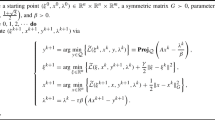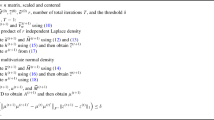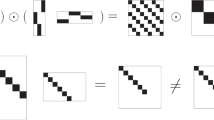Abstract
Box-constrained \(\ell _1\)-minimization in some cases performs remarkably better than the classical \(\ell _1\)-minimization when appropriate box constraints are available. And also many practical \(\ell _1\)-minimization models indeed involve box constraints. In this paper, we propose an efficient iteration scheme, dubbed the projected shrinkage (ProShrink) algorithm, to solve a class of box-constrained \(\ell _1\)-minimization problems. A key component in our technique is that the proximal point operator of \(\ell _1\)-norm with box constraints can be equivalently simplified into a projected shrinkage operator which can be calculated directly. Theoretically, we prove that ProShrink enjoys convergence of both the primal and dual point sequences. On the numerical level, we demonstrate the benefit of adding box constraints via sparse recovery experiments.



Similar content being viewed by others
Notes
Let \(\hat{x}\) be a sparse vector to be recovered and assume that its i-th entry \(\hat{x}_i\) is nonzero. Then, we say that \([-|\hat{x}_i|,|\hat{x}_i|]\) is a correct box constraint, also called right size box.
References
Bauschke, H.H., Combettes, P.L.: Convex Analysis and Monotone Operator theory in Hilbert Spaces. Springer, Berlin (2011)
Beck, A., Teboulle, M.: A fast iterative shrinkage-thresholding algorithm for linear inverse problems. SIAM J. Imaging Sci. 2(1), 183–202 (2009)
Bruckstein, A.M., Elad, M., Zibulevsky, M.: On the uniqueness of nonnegative sparse solutions to underdetermined systems of equations. IEEE Trans. Inf Theory 54(11), 4813–4820 (2008)
Cai, J.-F., Osher, S., Shen, Z.: Linearized Bregman iterations for compressed sensing. Math. Comput. 78(267), 1515–1536 (2009)
Chen, S., Donoho, D., Saunders, M.: Atomic decomposition by basis pursuit. SIAM Rev. 43(1), 129–159 (2001)
Combettes, P.L., Wajs, V.R.: Signal recovery by proximal forward–backward splitting. Multiscale Model. Simul. 4(4), 1168–1200 (2005)
Donoho, D.L., Tanner, J.: Sparse nonnegative solution of underdetermined linear equations by linear programming. Proc. Natl. Acad. Sci. 102(27), 9446–9451 (2005)
Güler, O.: On the convergence of the proximal point algorithm for convex minimization. SIAM J. Control Optim. 29(2), 403–419 (1991)
Lai, M.J., Yin, W.: Augmented \(\ell _1\) and nuclear-norm models with a globally linearly convergent algorithm. SIAM. J. Imaging Sci. 6(2), 1059–1091 (2013)
Moreau, J.J.: Fonctions convexes duales et points proximaux dans un espace hilbertien. C. R. Acad. Sci. Paris Ser. A Math. 255, 2897–2899 (1962)
Nesterov, Y.: Introductory Lectures on Convex Optimization: A Basic Course. Kluwer Academic Publishers, Berlin (2004)
O’Donoghue, B., Candès, E.: Adaptive restart for accelerated gradient schemes. Found. Comput. Math. 15(3), 715–732 (2015)
Parikh, N., Boyd, S.: Proximal algorithm. Found. Trends Optim. 1(3), 123–231 (2014)
Rockafellar, R.T.: Convex Analysis. Princeton University Press, Princeton (1970)
Rockafellar, R.T.: Monotone operators and the proximal point algorithm. SlAM J. Control Optim. 14(5), 877–898 (1976)
Takác̆, M., Marec̆ek, J., Richtárik, P.: Inequality-Constrained Matrix Completion: Adding the Obvious Helps! arXiv:1408.2467v1 [math.OC] (2014)
Vaswani, N., Lu, W.: Modified-CS: modifying compressive sensing for problems with partially known support. IEEE Trans. Signal Process. 58(9), 4595–4607 (2010)
Yin, W., Osher, S., Goldfarb, D., Darbon, J.: Bregman iterative algorithms for \(\ell _1\)-minimization with applications to compressed sensing. SIAM J. Imaging Sci. 1(1), 143–168 (2008)
Zhang, H., Cheng, L., Zhu, W.: A lower bound guaranteeing exact matrix completion via singular value thresholding algorithm. Appl. Comput. Harmonic Anal. 31(3), 454–459 (2011)
Zhang, H., Cai, J.-F., Cheng, L., Zhu, J.: Strongly convex programming for exact matrix completion and robust principal component analysis. Inverse Probl. Imaging 6(2), 357–372 (2012)
Zhang, H., Yin, W.: Gradient methods for convex minimization: better rates under weaker conditions. In: UCLA CAM Report (13–17), 2013
Zhang, H., Cheng, L.Z., Yin, W.: Dual algorithm for a class of augmented convex signal recovery models. Commun. Math. Sci. 13(1), 103–112 (2015)
Acknowledgments
We would like to thank Professor Wotao Yin (UCLA) for his comments and suggestion on numerical verification and Professor Jian-Feng Cai (Iowa U) for his insight of the projected shrinkage operator. We appreciate the constructive comments by anonymous reviewers, with which great improvements have been made in this manuscript. The work is supported by the National Science Foundation of China (Nos.11501569 and 61072118).
Author information
Authors and Affiliations
Corresponding author
Rights and permissions
About this article
Cite this article
Zhang, H., Cheng, L. Projected shrinkage algorithm for box-constrained \(\ell _1\)-minimization. Optim Lett 11, 55–70 (2017). https://doi.org/10.1007/s11590-015-0983-3
Received:
Accepted:
Published:
Issue Date:
DOI: https://doi.org/10.1007/s11590-015-0983-3




